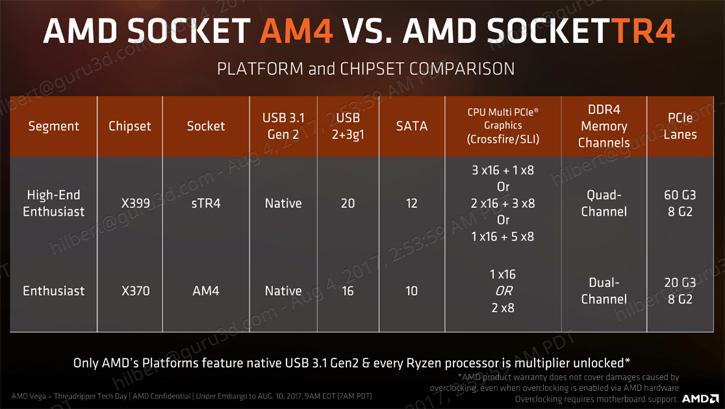The AMD X399 Chipset and Quad Channel memory
The X399 Chipset
Here things remain the same. Aside from a mandatory BIOS update, you're good to go. There will be some new motherboards launched and, with ASUS Zenith, if you plan to overclock the 32-core part, please opt for the now optional VRM cooler kit. While some of the chipset functionality is harbored inside the processor, a new generation and architecture processor will always require a new motherboard chipset. Let me first reiterate and make clear that ALL Ryzen processors are unlocked, that entails all Ryzen 3, 5, 7 and thus now the new Threadripper processors. Threadripper processors however will require a new socket due to the many pins needed. The platform will be using Socket design SP3r2, a 4094-pin socket that was originally developed for the AMD Naples (EPYC) series server processors, but again, AMD did a 180 and is introducing it also as a high-end desktop platform series of processors and chipsets.
The processing power that Threadripper offers is balanced by more memory bandwidth via quad DDR4 channels and it’s backed by up to a whopping uncompromising 64 PCIe 3.0 lanes for things like multiple graphics cards, many ultra-fast NVMe SSDs and fast USB and Ethernet. Threadripper ready motherboards will come with 8x DDR4 DIMM module slots that can hold a total of 128 GB of DDR4 memory and you will often see 4x PCIe x16 slots and support for up to three NVMe M.2 drives on these motherboards as, well, the motherboard manufacturers have enough PCIe 3.0 lanes to work with. PCI-Express Gen 3.0 is fully supported on all 64 PCIe Lanes, that means you also get full support for the NVMe protocol, USB 3.1 Gen 2 (10 Gbps) and M.2 and SATA Express support. Since Ryzen architecture processors have all the IO paths and a controller built in for USB 3.1 (Gen 2) as well, there will be PCIe lanes dedicated to your NVMe needs.
The X399 chipset will support multi-GPU rendering (Crossfire and SLI) with up-to four mechanical x16 PCI Express slots (Gen 3.0) and, connected from there onwards, endless possibilities in your configuration, say, 16x/16x/8x/8x Gen 3.0.
The Ryzen Threadripper processor has an I/O of 64 PCIe 3.0 lanes. The interlink between the Threadripper processor and X399 chipset is a 4x PCIE Gen 3 link - and then your X399 chipset will also offer an additional 20 (!) PCIe Gen 2 lanes and 12 (!) SATA3 ports. Again, four lanes function as an interconnect to the chipset. In the above screenshot, you can check how that works out compared to Ryzen / X370.
Quad channel DDR4 Memory
AMD brought DDR4 support to Ryzen 3 5 and 7, but that remained dual-channel. With Threadripper that quad-channel support is being introduced. The motherboards will be paired with eight DIMM slots, configurable as single, dual and quad-channel setup. AMD will support the standard JEDEC SPD timings and frequencies at 2133/2400 and 2667 MHz, but you can expect to see motherboards with support for 3200/3466 MHz (and higher up-to 3600 MHz) as well.
AMD's Memory configuration options - Uma (Distributed) or Numa (Local)?
With everything that is going on with Threadripper you already know that the physical size and layout of the processor is big. That also means some DIMM DDR4 channels are closer, while others are farther away from the memory controllers. You could describe that as near memory and perhaps far memory based on the distance of the two processor chips and their cores inside the package. Near memory has a latency in the 64ns range while far memory can pass 105s. AMD’s solution is to use Ryzen select (in BIOS or Ryzen Master) to flip between two memory modes.
UMA is the Distributed Mode memory control - it is the platform default and allows software to use all the DRAM evenly. Local Mode NUMA uses local memory near the die or chip to gain lower latency. Obviously, the number of modules of memory installed is trivial here, but we assume most end-users will use 4 DIMMs in quad-channel. This option will become available in Ryzen Master, but you can use the BIOS option to switch between the two memory modes. Generally, older/less threaded games might run slightly faster in the Local mode while the latest games/heavily threaded games (e.g. Ashes) will run better with the default Distributed mode. Very simply put, Distributed mode offers better bandwidth, Local mode offers lower latency. Our advice, play around with it a bit and run both modes to get the complete picture and select your preference. We can see Gamers end up at Local mode and, say, video editors at the default Distributed mode.
AMD Dynamic Local Mode
AMD will make the notable introduction of Dynamic Local Mode software for the Ryzen Threadripper WX Series processors, optimizing application performance by ensuring the most demanding threads always get preferential time on cores with local memory. Ryzen Threadripper 2970WX and 2990WX have 24 or 32 cores spread across four processor dies: two with direct access to local memory and two with access to memory via the Infinity Fabric. There are instances where the entire application or specific workloads can achieve the best performance when they’re executed on the two CPU dies with local/direct memory access. This is where the new Dynamic Local Mode will come in with Threadripper 2970WX and 2990WX CPUs to automatically migrate the system’s most demanding application threads onto the cores with local memory access. In other words: the apps that prefer local DRAM access will automatically receive it, and apps that scale to many cores will be free to do so. Install Ryzen master v1.5, and it's enabled. Mind you this only works for the WX models.






